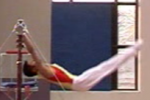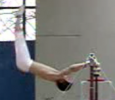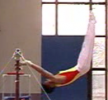Hello all, I very often get questions about dealing with the fear of Flyways, or Back Aways, from the High Bar, or Uneven Bars. I am hoping this post will provide some insight for those developing this element and will alleviate some anxiety that parallels acquiring this essential and fundamental skill and the 'dangers' that come with it.
Let us not beat around the bush - the main fear is the consequence of "pulling into" the bar. Bruised shins, blackened toes and sweaty palms are all symptoms of the dreaded "pulling in" during performance. What is "pulling in" you ask? "Pulling in" is the process of bringing the centre of mass into the bar upon release to such an extent that part of the body during rotation makes contact with the apparatus. More often then not the "pulling in" during basic level backward rotating dismounts, involves hitting the leg region at some location.
I have placed quotation marks around pulling in as it is an often used coaching cue to indicate what not to do. Before telling our gymnasts what not to do, lets examine why they are doing "it" and perhaps prescribe something to prevent them doing "it". Most coaches are familiar with parabolic trajectory so this post will not deal with this concept as if the gymnast does not have a properly timed tap swing - they should not be pursuing a release point. Therefore, the prescription advocated will deal with the bodies position upon release.
Why do gymnast pull into the bar? During the performance of the backward somersault the gymnast must, upon release, lift the feet in order to establish backward rotation effectively. During this lift of the feet, the gymnast will rely on a three different methods of varying degree. The three methods are - bending the straight-body-line through the shoulders, the hips (includes tucking), or creating a hollowing/concave shape through the entire body through the shoulder, trunk and hip region. The process of "pulling in" with a properly timed tap swing, occurs from the gymnast lifting the feet by breaking the shoulder angle.
Achieving a proper hollowing/concave position is a very mature developmental acquisition. It is important for beginner level gymnasts to achieve the proper lift of the feet in a manner they are capable of achieving - lifting the toes by bending through the hip region, or piking.
Piking is developmentally easier than hollowing/concaving the body. Piking into a release point is also a very effective way to establish rotation and lift the feet without bringing the centre of mass into the bar. The key is to 'isolate' the leg lift by using the abdominals and hip flexor region and not the should region. Let us look at an example -

This is a picture of a gymnast performing a layout backward somersault just prior to the release point. As you can see there are two apparent features - a pike to the hip region and a slight shoulder angle. The pike at the hips allows the gymnast to 'isolate' the leg lift therefore allowing the ability to establish rotation in a safe manner. The shoulder angle created is a natural occurrence and has not been emphasised.
Here is a release point of a double somersault in the layout position -

Notice the same characteristics on release of the piking in the hip region.
Most beginner gymnast that try to achieve a hollow/concave shape prior to release are not physically capable of performing this mature action and more often than not will achieve this lift of the feet by breaking the shoulder angle. Subsequently, this creates one of the most common thorns in the progress of dismounting - the dreaded "pulling in".
Let us not beat around the bush - the main fear is the consequence of "pulling into" the bar. Bruised shins, blackened toes and sweaty palms are all symptoms of the dreaded "pulling in" during performance. What is "pulling in" you ask? "Pulling in" is the process of bringing the centre of mass into the bar upon release to such an extent that part of the body during rotation makes contact with the apparatus. More often then not the "pulling in" during basic level backward rotating dismounts, involves hitting the leg region at some location.
I have placed quotation marks around pulling in as it is an often used coaching cue to indicate what not to do. Before telling our gymnasts what not to do, lets examine why they are doing "it" and perhaps prescribe something to prevent them doing "it". Most coaches are familiar with parabolic trajectory so this post will not deal with this concept as if the gymnast does not have a properly timed tap swing - they should not be pursuing a release point. Therefore, the prescription advocated will deal with the bodies position upon release.
Why do gymnast pull into the bar? During the performance of the backward somersault the gymnast must, upon release, lift the feet in order to establish backward rotation effectively. During this lift of the feet, the gymnast will rely on a three different methods of varying degree. The three methods are - bending the straight-body-line through the shoulders, the hips (includes tucking), or creating a hollowing/concave shape through the entire body through the shoulder, trunk and hip region. The process of "pulling in" with a properly timed tap swing, occurs from the gymnast lifting the feet by breaking the shoulder angle.
Achieving a proper hollowing/concave position is a very mature developmental acquisition. It is important for beginner level gymnasts to achieve the proper lift of the feet in a manner they are capable of achieving - lifting the toes by bending through the hip region, or piking.
Piking is developmentally easier than hollowing/concaving the body. Piking into a release point is also a very effective way to establish rotation and lift the feet without bringing the centre of mass into the bar. The key is to 'isolate' the leg lift by using the abdominals and hip flexor region and not the should region. Let us look at an example -

This is a picture of a gymnast performing a layout backward somersault just prior to the release point. As you can see there are two apparent features - a pike to the hip region and a slight shoulder angle. The pike at the hips allows the gymnast to 'isolate' the leg lift therefore allowing the ability to establish rotation in a safe manner. The shoulder angle created is a natural occurrence and has not been emphasised.
Here is a release point of a double somersault in the layout position -

Notice the same characteristics on release of the piking in the hip region.
Most beginner gymnast that try to achieve a hollow/concave shape prior to release are not physically capable of performing this mature action and more often than not will achieve this lift of the feet by breaking the shoulder angle. Subsequently, this creates one of the most common thorns in the progress of dismounting - the dreaded "pulling in".
